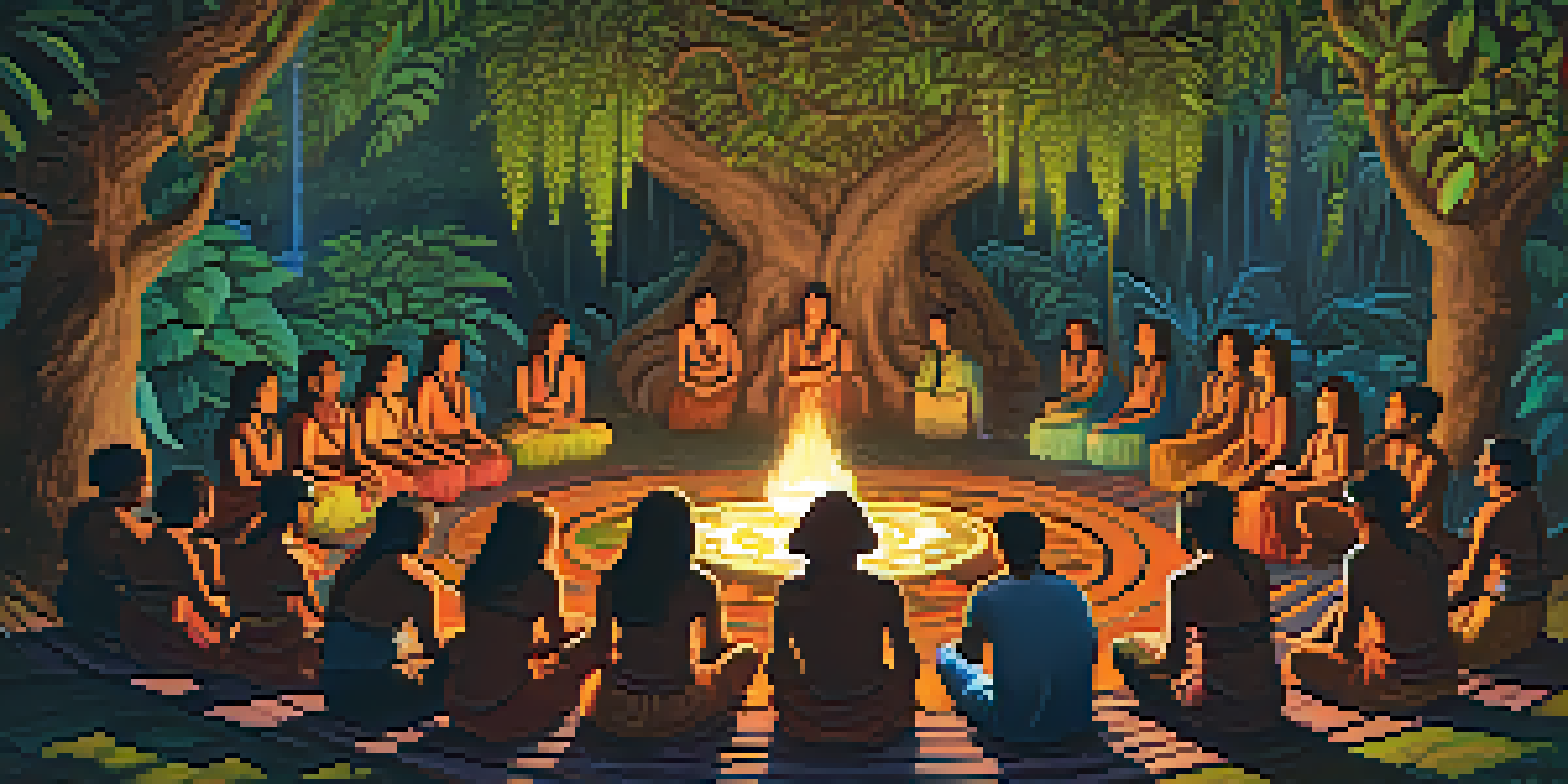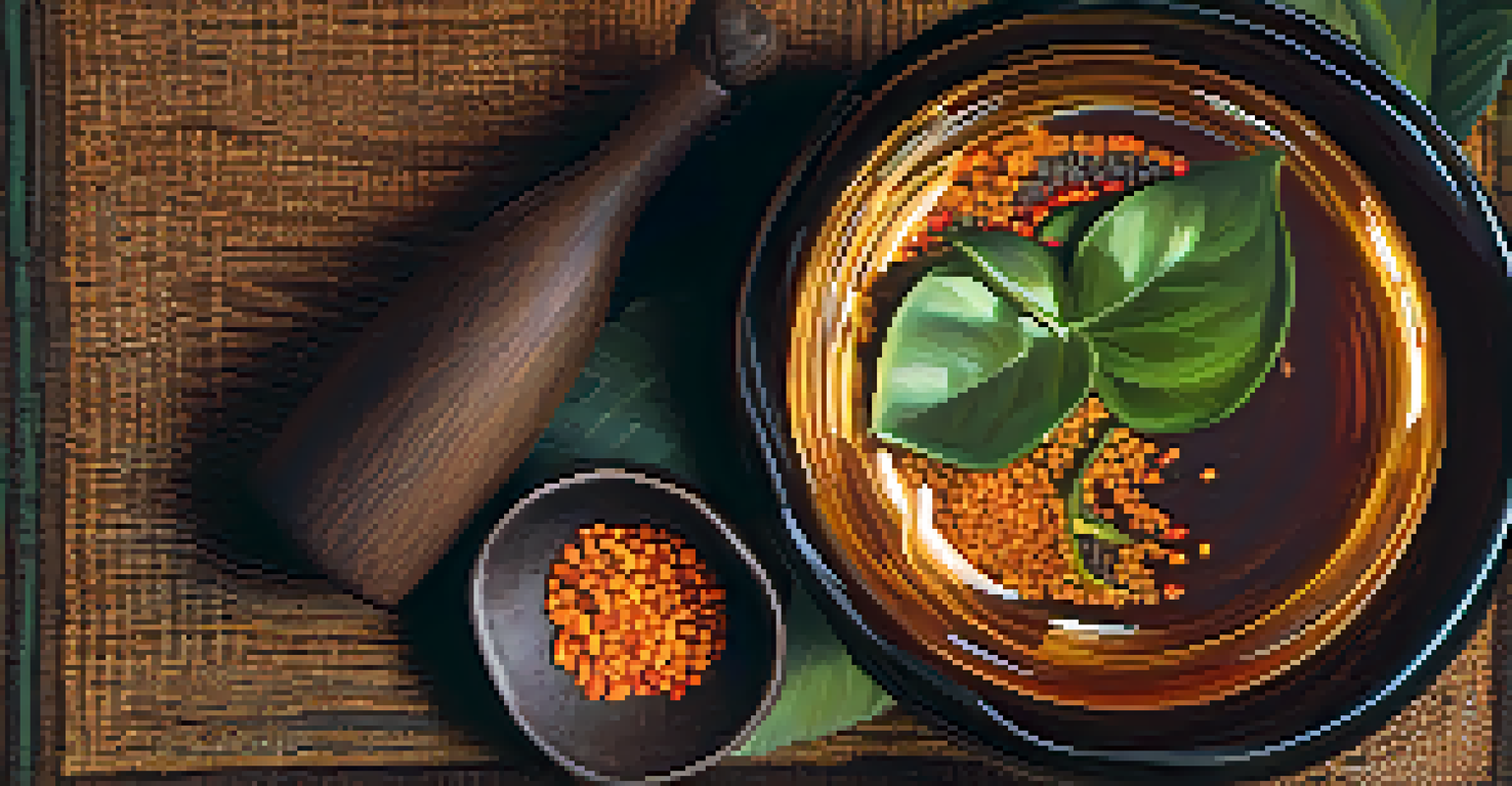Spiritual Healing: The Ayahuasca Experience Explained

What is Ayahuasca and Its Origins
Ayahuasca is a powerful brew made from the leaves of the Psychotria viridis plant and the bark of the Banisteriopsis caapi vine. This ancient concoction has been used for centuries by indigenous tribes in the Amazon rainforest for spiritual healing and rituals. The term 'ayahuasca' translates to 'vine of the souls,' highlighting its profound connection to the spirit world.
The greatest journey is the journey inward.
Traditionally, shamans or healers guide participants through the ayahuasca experience, helping them navigate the emotional and spiritual landscapes that arise. This practice is not just about consuming the brew; it’s about entering a sacred space that fosters healing and self-discovery. The ritual often includes music, chanting, and other elements that enhance the experience.
In recent years, ayahuasca has gained popularity beyond its native regions, attracting those seeking personal transformation or healing from trauma. However, it’s essential to approach this journey with respect and caution, as the experience can be both intense and enlightening.
The Science Behind Ayahuasca
Research indicates that ayahuasca contains DMT, a powerful psychedelic compound. When ingested, it interacts with serotonin receptors in the brain, leading to altered states of consciousness. This chemical reaction is believed to facilitate deep introspection and emotional release, making it a unique tool for spiritual healing.

Studies have shown that individuals who participate in ayahuasca ceremonies often report significant reductions in symptoms of anxiety, depression, and PTSD. This suggests that the brew may have therapeutic benefits that extend beyond the immediate experience. However, it’s crucial to note that the outcomes can vary widely among individuals.
Ayahuasca's Spiritual Significance
Ayahuasca, known as 'vine of the souls,' is a traditional brew used by Amazonian tribes for spiritual healing and self-discovery.
The integration of the insights gained during the experience is vital for lasting change. Participants are often encouraged to reflect on their journeys and consider how to apply these lessons to their daily lives, bridging the gap between the spiritual and practical realms.
Preparing for the Ayahuasca Journey
Preparation is a key aspect of the ayahuasca experience. Many practitioners recommend adhering to a specific diet, known as the 'dieta,' prior to the ceremony. This usually involves avoiding alcohol, caffeine, and certain foods to ensure a clear mind and body, which can enhance the effects of the brew.
Healing is not linear. It is a spiral, a journey that takes us through many layers of our being.
Mental and emotional readiness is also crucial. Engaging in practices such as meditation or journaling can help you set intentions and clarify what you hope to achieve during the ceremony. This mindset can significantly influence your experience and the insights you gain.
It's equally important to choose a reputable healer or retreat. Researching facilitators and reading reviews can help ensure a safe and supportive environment, as the journey can be unpredictable and emotionally charged.
What to Expect During the Ceremony
The ayahuasca ceremony typically takes place in a dimly lit, comfortable space, often accompanied by other participants. After consuming the brew, individuals may begin to feel its effects within 30 to 60 minutes. Common experiences include visual and auditory hallucinations, physical sensations, and an overwhelming sense of connectedness.
It's not uncommon for participants to confront deep-seated emotions or traumatic memories, which can be both cathartic and challenging. The guidance of a shaman is invaluable during this time, as they offer support and reassurance, helping individuals navigate through their experiences.
Therapeutic Benefits of Ayahuasca
Research indicates that ayahuasca may aid in reducing symptoms of anxiety, depression, and PTSD, offering potential therapeutic benefits.
The duration of the experience can last several hours, often leading participants to a state of introspection and reflection. Many describe feelings of clarity and understanding, as if they've gained new perspectives on their lives and relationships.
Post-Ceremony Integration
After the ceremony, participants often enter a phase of reflection and integration. This is where the real work begins, as individuals process their experiences and insights. Journaling or discussing the journey with trusted friends or therapists can facilitate this process.
Integration is crucial for translating the lessons learned during the ceremony into actionable changes in daily life. Many find that the insights gained can influence their relationships, career paths, and overall well-being, fostering a sense of purpose and direction.
Support groups or integration circles can also be beneficial, providing a safe space for participants to share their experiences and support one another. Building a community around these shared experiences can create lasting connections and encouragement on the healing journey.
Potential Risks and Considerations
While ayahuasca has many reported benefits, it's not without risks. Individuals with certain medical conditions or those taking specific medications should exercise caution, as interactions can lead to severe side effects. Always consult with a healthcare professional before considering ayahuasca.
The psychological effects can also be intense, potentially leading to overwhelming emotions or anxiety during the experience. It's important to approach this journey with an open mind and a willingness to face uncomfortable truths. Having a skilled facilitator can help mitigate these risks.
Importance of Integration After Use
Post-ceremony integration is crucial for translating insights gained during the experience into meaningful changes in daily life.
Moreover, the authenticity of the experience heavily depends on the environment and the guide. Ensuring that you are in a safe, reputable setting can make all the difference in how the experience unfolds.
The Broader Impact of Ayahuasca
The growing interest in ayahuasca has sparked conversations about mental health and spiritual healing worldwide. Many are turning to indigenous practices as alternatives to conventional therapies, seeking holistic approaches to well-being. This shift highlights the importance of respecting and understanding the cultural significance of these practices.
Ayahuasca is not just a trend; it represents a deeper yearning for connection, understanding, and healing in our increasingly complex world. As more people embark on this journey, there's a collective hope that it can pave the way for greater empathy and compassion.

However, it's essential to approach this journey with respect for its origins and the communities that have used it for generations. Engaging with these practices mindfully can lead to transformative experiences that honor both personal growth and cultural heritage.